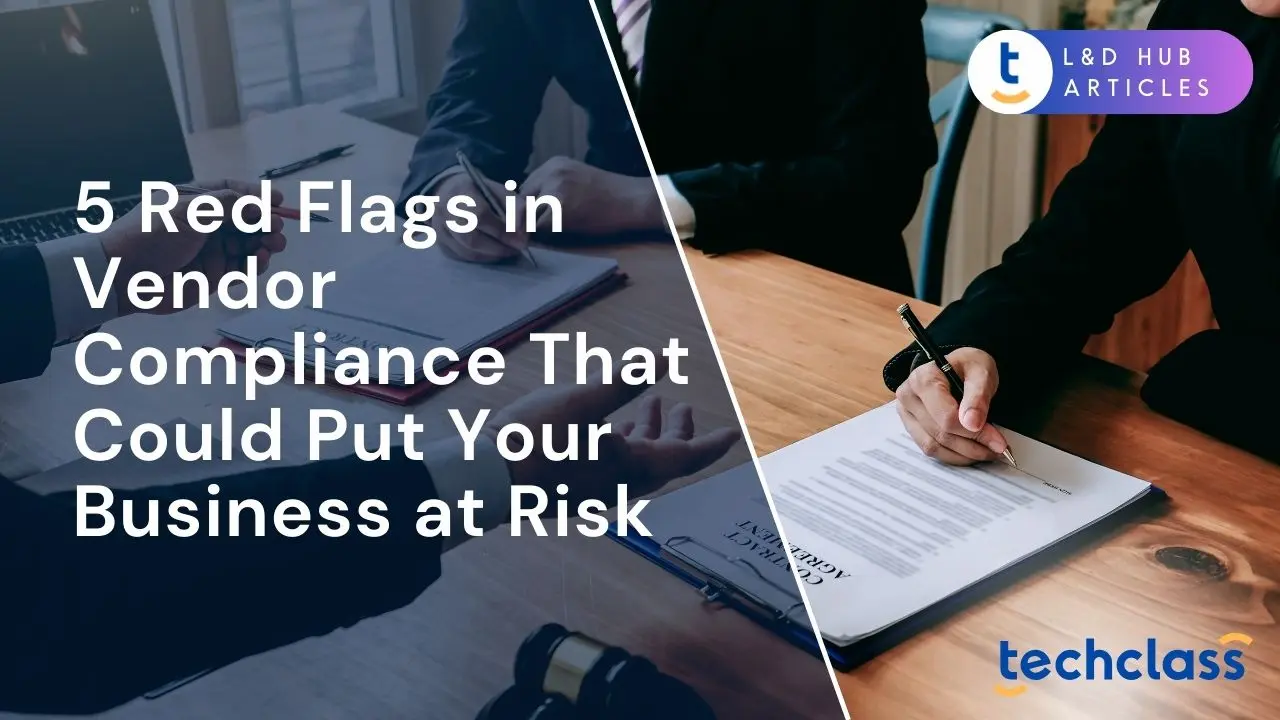
The global business landscape increasingly relies on third-party vendors and service providers, from cloud computing partners to supply chain manufacturers. While these partnerships bring agility and expertise, they also introduce significant risks, especially if a vendor falls short on compliance obligations. Vendor compliance refers to how well your suppliers and partners adhere to relevant laws, regulations, and ethical standards on your behalf. When a vendor fails in this area, the repercussions can directly impact your organization, ranging from data breaches and legal fines to reputational damage. Understanding the warning signs of vendor non-compliance is crucial for HR professionals, CISOs, business owners, and enterprise leaders alike, as early detection of these red flags can prevent costly problems down the road.
In this article, we highlight five major red flags in vendor compliance that could put your business at risk. From weak data security practices to a lack of transparency, being aware of these warning signs will help your organization strengthen its third-party risk management. Each section below explores a specific red flag, offers real-world examples or statistics, and provides insight into why it matters and how to address it. By proactively identifying these issues, companies can better protect themselves in an environment where vendor risk management is more important than ever.
One of the clearest warning signs is a vendor’s inability, or unwillingness, to demonstrate that they meet relevant compliance standards. In highly regulated sectors (such as finance, healthcare, or manufacturing), reputable vendors will typically maintain up-to-date certifications, audit reports, or attestations to prove their compliance. Regular Compliance Training ensures internal teams understand how to assess these credentials effectively and recognize gaps before entering vendor partnerships. For instance, an IT service provider handling sensitive or personal data might hold certifications such as ISO/IEC 27001 (for information security management) or provide a SOC 2 Type II report verifying the effectiveness of its internal controls over time. In the healthcare sector, U.S. vendors may also need to show HIPAA compliance, while financial service providers may need to meet PCI DSS requirements for payment data security.
This lack of documented compliance can put your business at risk in multiple ways. For one, regulatory laws often hold companies accountable for the compliance failures of their third parties. If your vendor isn’t compliant with a law like the General Data Protection Regulation (GDPR) or the California Consumer Privacy Act (CCPA), your company could face hefty fines for any resulting data mishandling. Similarly, in areas like workplace safety or environmental protection, using a non-compliant supplier could lead to liability or supply chain disruptions. HR departments should also be wary of vendors that cannot show compliance with labor laws and ethical standards, no company wants to be associated with a supplier who violates wage regulations or employs unethical practices. In short, a vendor’s lack of compliance credentials or documentation is an early warning sign that partnering with them might carry hidden liabilities.
In today’s digital economy, data security and privacy compliance are non-negotiable. If a vendor exhibits poor cybersecurity practices, that’s a glaring red flag. Indicators might include an absence of formal security policies, outdated or unpatched systems, lack of data encryption, or employees not trained in privacy protection. Such weaknesses have tangible consequences: many of the biggest data breaches in recent years have stemmed from third-party vendors with subpar security practices.
In fact, research shows that a significant proportion of data breaches involve a third-party vendor. One study found that roughly 59% of companies experienced a data breach caused by one of their third parties. A famous example is the Target retail breach of 2013, which occurred after attackers gained access to Target’s network through a heating and ventilation (HVAC) contractor with inadequate security measures. That incident led to the exposure of 40 million customer payment card records and cost Target hundreds of millions of dollars in damages and remediation.
The lesson is clear, a vendor with weak data protection not only jeopardizes their own systems, but also becomes a threat to your organization. Companies affected by third-party breaches often face customer lawsuits, regulatory fines, and irreparable loss of trust. For CISOs and enterprise security teams, it’s critical to vet vendors for strong security hygiene, for example, by requiring measures like multi-factor authentication, regular vulnerability assessments, and compliance with standards such as PCI-DSS for any service handling payment data. If a vendor cannot clearly articulate their security controls or has a history of security incidents, partnering with them could put your sensitive information at risk.
Another red flag is a vendor’s track record, specifically, any history of compliance violations, regulatory penalties, or serious legal disputes. Past behavior is one of the best predictors of future behavior; if a supplier has been fined or publicly cited for non-compliance before, you should tread carefully. This could range from data privacy violations (e.g. a vendor fined for mishandling personal information) to labor law infractions (e.g. a subcontractor caught with unsafe working conditions or wage theft). For example, the catastrophic Rana Plaza factory collapse in 2013, which killed over 1,100 garment workers, revealed that many Western apparel companies had been unknowingly relying on a supplier with egregious safety violations. That incident not only exposed horrific working conditions at a third-party factory but also thrust the global brands involved into a storm of criticism and reputational damage.
Enterprise leaders and compliance teams should conduct due diligence by checking public records, news reports, and industry watchlists for any red flags in a vendor’s past. If a prospective vendor has been involved in fraud, lawsuits, or regulatory actions (such as sanctions for violating export controls or environmental fines), it signals potential trouble ahead. In highly regulated industries like finance, regulators even expect companies to know if their vendors have had run-ins with the law. A bank, for instance, could be penalized if its third-party contractor engages in activities like facilitating money laundering or fraud under the bank’s watch. The bottom line: a vendor with a checkered compliance history could very well entangle your business in similar problems later. It’s far safer to choose partners with clean records and a demonstrated culture of ethical compliance.
Trustworthy vendors understand that compliance is a shared responsibility and will cooperate with reasonable oversight. If a vendor is reluctant to share information, answer due diligence questionnaires, or allow on-site inspections and audits, consider it a serious warning sign. A lack of transparency might mean the vendor has something to hide or simply does not prioritize good governance. Many regulatory frameworks (including financial services regulations and quality management standards) emphasize the importance of ongoing vendor monitoring. If your vendor pushes back on contract clauses that grant your company audit rights or if they refuse to provide regular compliance updates, you have to wonder why.
From a practical standpoint, visibility into a vendor’s operations is key to managing third-party risk. Your organization should be able to obtain information such as the vendor’s security controls, business continuity plans, and subcontractor practices. Without this visibility, you’re essentially operating blind and hoping for the best, a risky proposition. Research bears this out: in one study, only 34% of companies could identify all the third parties touching their sensitive data. Likewise, a 2019 global survey found that more than half of organizations lack adequate visibility into the compliance and risk practices of their vendors. This blind spot can be dangerous. Imagine discovering too late that one of your critical suppliers had outsourced part of your project to an unknown fourth-party with no oversight, or that they suffered a security incident months ago and never informed you. Clear communication and audit cooperation from vendors are essential; a vendor who stonewalls such efforts is waving a red flag that shouldn’t be ignored.
A subtler but equally important red flag is when a vendor lacks an internal culture of compliance. If the vendor does not have a formal compliance program, for instance, no designated compliance officer, no employee training on ethics and regulations, and no clear internal policies, it indicates that compliance is not a priority in their organization. Such a vendor might not intentionally break rules, but the absence of a structured compliance framework greatly increases the likelihood of oversights or misconduct. For example, if a payroll processing firm has never trained its staff on data privacy requirements or anti-fraud practices, it’s only a matter of time before a mistake or malicious act occurs that could harm your business.
On the flip side, vendors with robust compliance programs tend to communicate their commitment openly. They may have a published code of conduct, regular staff training sessions, and independent audits of their practices. When those elements are missing, take notice. A vendor with no compliance training may also inadvertently foster a culture where employees think “anything goes,” which can lead to unethical or illegal behaviors like bribery, fraud, or intellectual property theft. Under U.S. law, the Foreign Corrupt Practices Act (FCPA) contains anti-bribery provisions and books-and-records/internal-controls requirements and can expose U.S. issuers, U.S. persons, and certain acts committed within U.S. jurisdiction to enforcement. Companies can be liable when third-party agents or intermediaries pay bribes to foreign officials on their behalf—particularly where the company knew, consciously avoided knowledge of, or failed to conduct reasonable due diligence regarding the intermediary’s bribery risk. The UK Bribery Act 2010 is broader in some respects: it creates a corporate offense where a company fails to prevent bribery by persons providing services for or on behalf of the company unless the company can show it had “adequate procedures” to prevent it. In fact, analysis has found that third-party intermediaries were involved in roughly 75% of global bribery cases examined. Thus, hiring a vendor without an ethics and compliance program could directly land your company in legal trouble if that vendor’s employees engage in wrongdoing on your behalf. As a best practice, your procurement and HR departments should always inquire about a vendor’s compliance management efforts, a serious vendor will have a clear answer, whereas a red-flag vendor might dismiss the topic as unimportant.
In an era of complex supply chains and outsourced operations, vendor vigilance is no longer optional, it’s a critical component of enterprise risk management. The red flags outlined above serve as early warning indicators that a vendor might pose a compliance risk. By paying attention to these signs, organizations can take proactive steps, such as performing more thorough due diligence, imposing stricter contract clauses, or even reconsidering the vendor relationship altogether. Remember that when it comes to third-party compliance, an ounce of prevention is worth a pound of cure: it is far easier to address issues upfront than to deal with a full-blown compliance failure after the fact.
Ultimately, building a strong vendor compliance program requires cross-functional effort. HR leaders, for instance, can incorporate compliance criteria into the onboarding and evaluation of contractors, while CISOs enforce cybersecurity assessments for all new vendors. Business owners and executives should champion a culture that values ethical partnerships, making it clear that doing business the right way is the only way. No matter the industry, the goal remains the same: to minimize surprises and ensure that every vendor you work with upholds the standards that protect your business and its stakeholders. By staying vigilant and addressing these five red flags in vendor compliance, your organization can reduce risk and foster more resilient, trustworthy vendor relationships.
Vendor compliance refers to how well suppliers and partners follow relevant laws, regulations, and ethical standards on your behalf. It’s important because non-compliance by a vendor can lead to legal fines, security breaches, and reputational damage for your business.
The main warning signs include no proof of compliance or certifications, weak data security practices, a history of violations, lack of transparency or refusal to be audited, and no internal compliance program or training.
Vendors with poor data protection can be the entry point for cyberattacks and breaches. If their systems are compromised, your sensitive data could be exposed, leading to lawsuits, fines, and loss of customer trust.
Transparency allows you to verify a vendor’s compliance and risk management practices. Without visibility into their operations, you may miss critical issues such as undisclosed subcontractors or unreported incidents.
You can strengthen compliance by conducting thorough due diligence, requiring proof of certifications, including audit rights in contracts, regularly monitoring vendor practices, and only partnering with vendors who demonstrate a clear commitment to ethical and legal standards.


